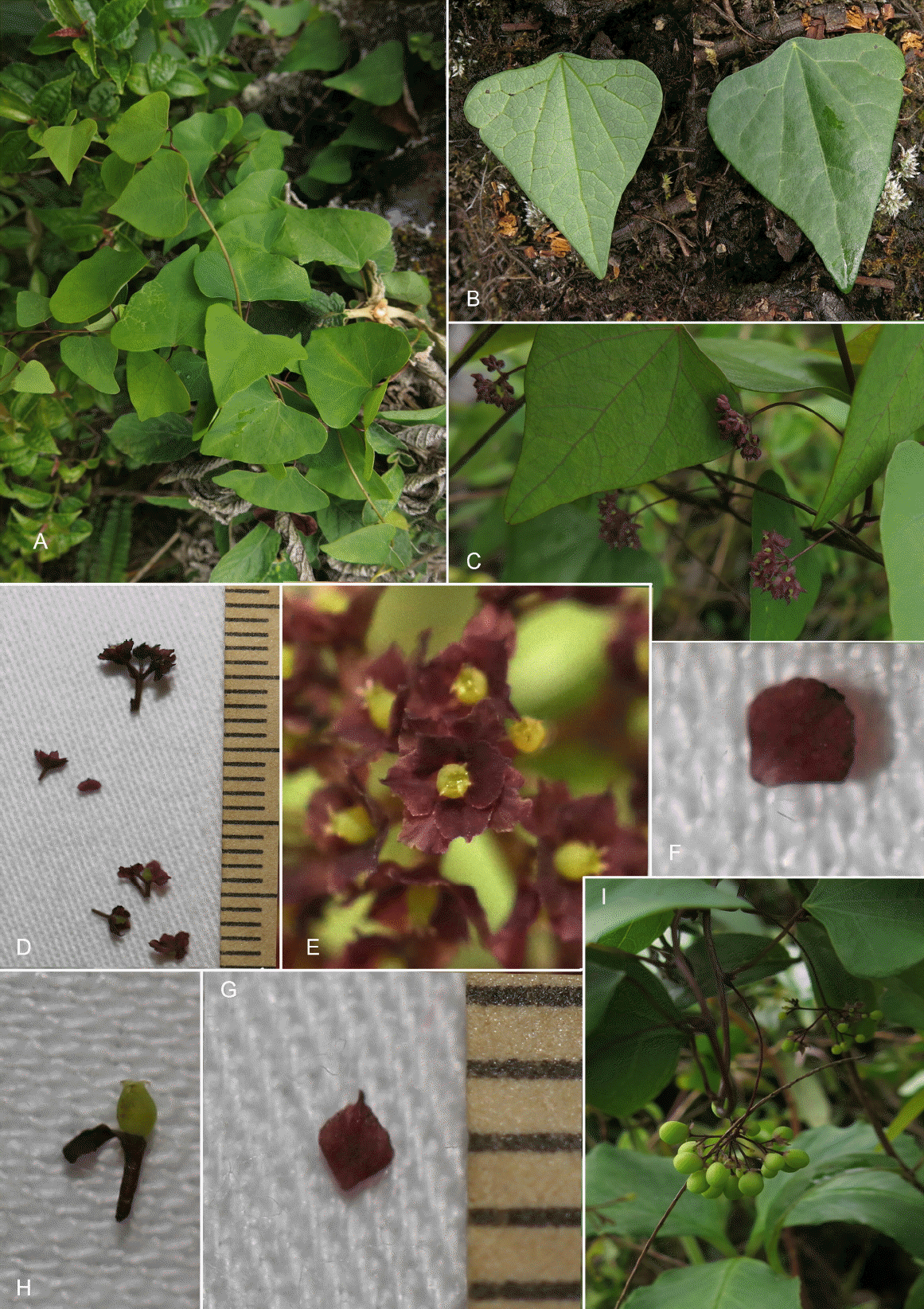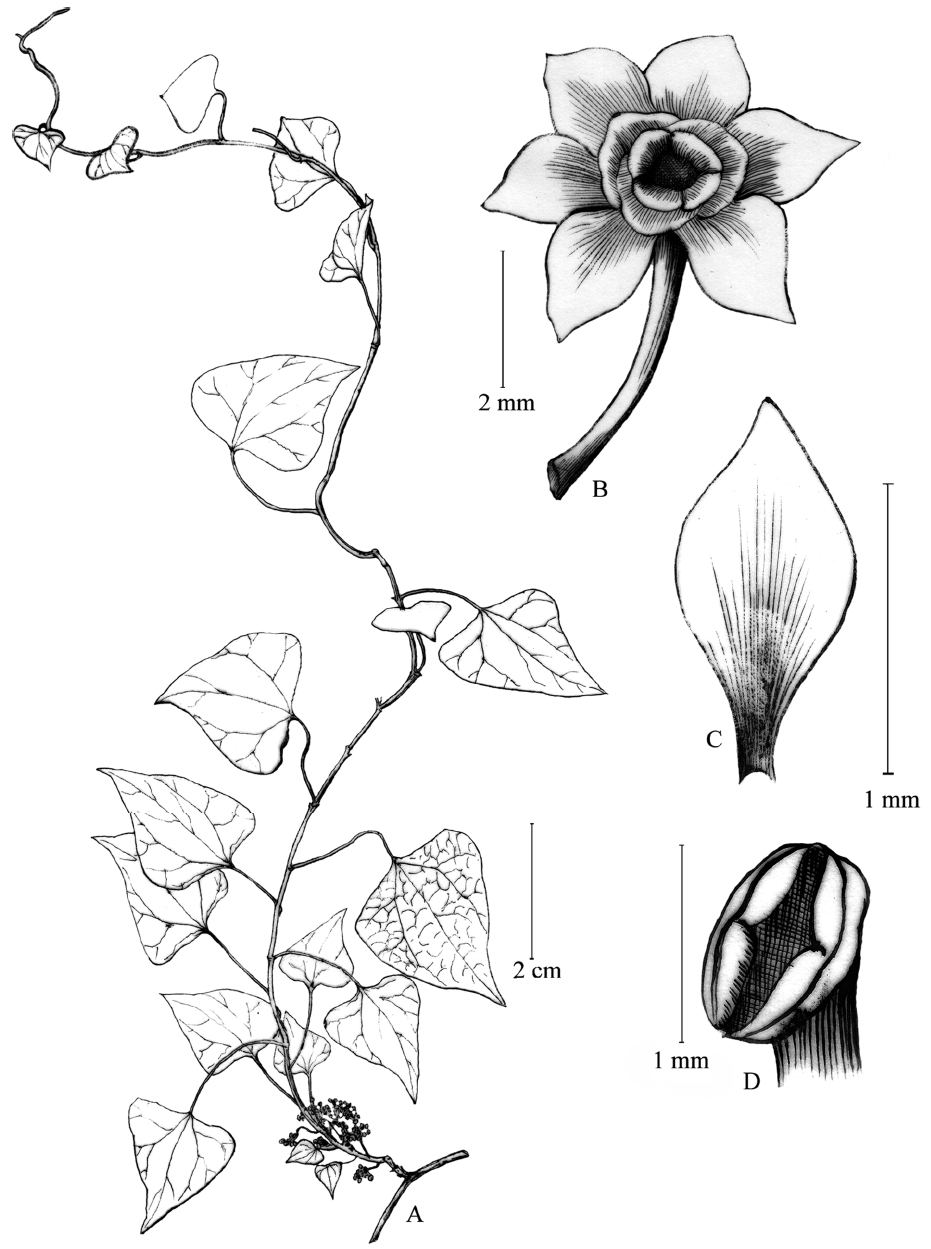Stephania subpeltata H. S. Lo: 베트남 미기록종
Stephania subpeltata H. S. Lo (Menispermaceae): A new record for the Flora of Vietnam
Article information
Abstract
Stephania subpeltata (방기과)의 베트남 분포를 처음으로 보고한다. 본 종은 형태적으로 S. japonica와 유사하지만 엽신이 방패모양에 가까운 난상삼각상 또는 넓은 삼각상이며, 엽병이 조금 더 짧고, 잎맥의 수가 적으며, 작은 화경에 산형모양의 취산화서가 달리지만 드물게는 복취산화서를 가지며, 꽃이 자색이고 내과피 에 돌출된 열의 수가 적어 뚜렷하게 구별된다. 본 종의 분류학적 기재, 상세 분포 및 생태학적 정보와 함께 베트남에 분포하는 함박이속(Stephania) 식물의 종검색표를 제시하였다.
Trans Abstract
The Vietnamese occurrence of Stephania subpeltata H. S. Lo (Menispermaceae) is reported here for the first time. It is morphologically allied to S. japonica but differs in having subpeltate, ovate deltoid or broadly deltoid to subdeltoid leaves, shorter petiole, fewer leaf veins, conspicuously pedicellate umbelliform cymes which are seldom compound, and purple flowers and endocarp with a reduced number of abaxial rows. A taxonomic description, distribution details, ecology, and a key to the Vietnamese species of Stephania are provided.
The family Menispermaceae has a tropical and subtropical distribution and comprises 71 genera and c. 350 species (Forman, 1991) in the World. All members of the family are unisexual and dioecious. However, some species belonging to genus Tiliacora and Parabaena are known to possess bisexual flowers. The family is closely related to Lardizabalaceae, but can be easily distinguished by its drupaceous fruit and the often curved horseshoe-shaped embryo.
Stephania is one of the biggest genera belonging to Menispermaceae and was firstly described in Flora Cochinchinensis (De Loureiro, 1790) characterized by a peltate synandrium, a unicarpellous ovary, peltate leaves with long petioles, small flowers grouped into umbelliform cymes or condensed into heads, alternate sepals and petals in the pistillate flowers and often two whorls of sepals in the staminate flowers (Luo, 1982; Luo et al., 2008).
Most species of Menispermaceae contain bioactive compounds, such as alkaloids, flavonoids, lignans, steroids, terpenoids, and coumarins (Semwal et al., 2010). Members of the genus Stephania have long been used in Traditional Chinese Medicine (Zheng, 1986; Zhu et al., 2007; Chi et al., 2008). The medicinal value of alkaloids from Stephania species has been studied by various workers (Zhu et al., 1983; Huang and Guo, 1998; Semwal et al., 2010). Even some studies investigated the chemotaxonomy of the genus (Yang and Chen, 1994; Huang et al., 1999). Of late, the molecular phylogenetic study on the Chinese species of the genus has been carried out using ITS and trnL-F markers (Xie et al., 2015). The study emphasized on further phylogenetic investigations including more accessions from different parts of the world. Currently, the genus comprises about 60 species mostly distributed in tropical and subtropical Asia (Diels, 1910; Lo, 1978; Forman, 1988, 1991; Hô, 1991; Hu et al., 2008) or Africa, with some species found in Oceania (Kessler, 1993). Among them, 37 species are recorded in China (Hu et al., 2008), 15 in Thailand (Forman, 1991), and seven species and one variety in Laos (Newman et al. 2007). In Vietnam, the genus consists of 13 species (Bân, 2003). However, S. hernandiifolia (Willd.) Walp. has now been synonymized with S. japonica var. discolor (Blume) Forman, therefore, the number comes down to 12 species. While examining the Stephania specimens housed in the Herbarium of Institute of Ecology and Biological Resources (HN) in Hanoi, Vietnam, two specimens of the same species were encountered which did not correspond to any known Vietnamese species. During our routine floristic surveys, a population of 20–30 individuals of the same plant was also seen in Phu Ho Village of Quan Ba District in Vietnam (Fig. 1). Efforts to locate it in the surrounding areas were without success. After the critical morphological study, consultation of relevant literature (Hô, 1991; Bân, 2003) and type specimens, we could identify them as Stephania subpeltata H.S. Lo, a newly recorded species for the flora of Vietnam. A detailed description, photographs, and illustration (Figs. 2, 3) are provided. S. subpeltata H. S. Lo, belongs to the ‘root non tuberous’ group which comprises S. japonica (Thunb.) Miers, and S. longa Lour. from Vietnam. Morphological comparison of S. subpeltata with these species is provided in Table 1. A taxonomic key to all Vietnamese Stephania species is also provided.

Stephania subpeltata H. S. Lo. A. Habit. B. Leaves. C, D. Female inflorescence. E. Pistillate flowers. F. Sepal. G. Petal. H. Stigma. I. Drupes (photographs by V. T. Chinh).

Stephania subpeltata H. S. Lo. A. Habit of male plant with inflorescence. B. Male flower. C. Sepal. D. Synandrium (drawn by Ding-Han Cui, based on CBL 1808).
Taxonomic Treatment
Stephania subpeltata H. S. Lo. Acta Phytotax. Sin. 16: 10, 1978.–TYPE: CHINA. Yunnan: Yangbi County, Pan Jia He, under mixed forest, 6 Nov 1940, Ching 25511 (Holotype: PE, not seen; Isotype: KUN!).
Climbers, 1–2 m long, herbaceous, glabrous, dioecious. Stems longitudinally striate. Petiole 1.5–2.5 cm, inserted 1–2 mm from the base of blade; leaf blade subpeltate, ovate deltoid or broadly deltoid, thin leathery, 3–8(−10) × 2–5 cm, base slightly concave, apex caudate or acuminate, slightly obtuse, often dark green when dry, 5-nerved. Male and female inflorescences isomorphic and composed of simple umbelliform cymes, few flowered; peduncle filamentous, 1–3.5 cm, with 3–5 cymelets fascicled; bracteole narrowly lanceolate, ca. 0.4 × 0.2 mm. Male flowers violet to greenish, sepals 6, in 2 whorls, outer whorl ovate, inner whorl sublanceolate, 1.5–2mm × ca. 1 mm, apex caudate; petals 3, in 1 whorl, broadly cuneate, 0.4–0.5 mm × 0.4–0.5 mm, violet. Stamens connate into a peltate synandrium. Synandrium 0.5–1 mm. Female flowers: perianth symmetrical; sepals 3, in 1 whorl, broadly ovate, ca. 1.5 mm × 0.8 mm, apex caudate; petals 3, in 1 whorl, oblate to broadly cuneate, ca. 0.6 mm × 0.5 mm; stigma 3-lobed, carpel 1, subovoid. Drupes orange-red, obovoid; endocarp 4.5–5 × 2–3 mm, dorsally bearing 4 rows of ornamentation, 2 rows closing to midrib dotted, lateral rows transversely ridged. Seed horseshoe-shaped.
Distribution: China (Yunnan, Guangxi, Guizhou, Sichuan, and Xizang), Thailand (Chiang Mai), and Vietnam (Ha Giang).
Specimens examined: VIETNAM. Ha Giang Province: Meo Vac District, Sung Chang Municipality, 29 Apr 1999, K. L. Phan, H. H. Pham & L. Averyanov CBL 1808 (HN!); Dong Van District, Pho Ban, 1 Jul 1999, Ngo Van Trai 3676 A, B (NIMM!); Quan Ba District, Phu Ho village, 16 Jul 2014, Vu Tien Chinh 108 (HN!).
Ecology: The species occurs on the limestone hills, shrublands, up to ca. 1,100 m elevation. The present collection was found growing in forest edges and thickets along roadside with Arisaema lidaense J. Murata & S. K. Wu, Hedyotis havilanddii King, Tinospora sagitata (Oliv.) Gagn., Macaranga denticulata (Blume) Muell., Dendrotrophe frutescens (Benth.) Danser., Lasianthus kerrii Craib, and Lasianthus cupreus Pierre. Flowering in April and fruiting from December to January.
Key to Stephania species in Vietnam
1. Rootstock not tuberous ··················································· 2
1. Rootstock tuberous ························································· 4
2. Inflorescences hispidulous ···························· S. longa
2. Inflorescences glabrous ············································· 3
3. Leaf palmately 9–11 nerved. Petiole inserted over 3–4 mm from the basal margin of lamina. Male flowers with 6 or 8 sepals, 3 or 4 petals, yellowish green; female flowers with 6–8 sepals, 3–4 petals ································································ S. japonica
3. Leaf palmately 5 nerved. Petiole inserted over 1–2 mm from the basal margin of lamina. Male flowers with 6 sepals, 3 petals, purple; female flowers with 3 sepals and 3 petals ························· S. subpeltata
4. Inflorescences capitate, with discoid receptacle ········································································ S. cepharantha
4. Inflorescences compound umbelliform cymes, without discoid receptacle ······················································· 5
5. Male flowers: sepals 4 or 5, petals absent ················································································ S. pierrei
5. Male flowers: sepals 6, petals 3 ·························· 6
6. Plant with red sap. Stems pinkish ················· 7
7. Leaf palmately veined. Blade margin toothed. Endocarp abaxially ornamented with 2 rows, 18–20 rows of transverse ridge ····· ····················································· S. dielsiana
7. Leaf palmately veined but semi-regular. Blade margin not toothed. Endocarp abaxially ornamented with 4 rows, 12–16 rows of transverse ridges ············· S. venosa
6. Plant without red sap. Stem greenish ············ 8
8. Male flowers: petals 4 ·········· S. cambodica
8. Male flower: petal 3 ··································· 9
9. Petiole ca. 30 cm ······················ S. sinica
9. Petiole 8–18 cm ··································· 10
10. Male flowers: sepals yellow. Female flower: sepal 3 or 5 ······· S. rotunda
10. Male flowers: sepals green. Female flower: sepal 1 or 2 ····················· 11
11. Male flowers: sepals dark green, outer 1.7–2.2 mm long. Female flowers: sepals 1, ovate, ca. 1 mm; endocarp 9–10 × 8 mm, condyle not perforated ·· S. brachyandra
11. Male flowers: sepals light green, outer 1.5–1.6 mm long. Female flowers: sepals 1 or 2, subovate, ca. 3 mm; endocarp 5–6 × 4–5.5 mm, condyle perforated ································· S. kwangsiensis
Acknowledgements
Authors are thankful to the South China Botanical Garden (SCBG) of the Chinese Academy of Sciences (CAS) for providing research facilities and financial support. We would like to thank the curators of Herbaria HN, HNPI, HNPM, K, KRIB, KUN, P, PE, VNM and the herbarium of the Scientific Committee of Lao (PDR) for their help during this research. This research is funded by Vietnam National Foundation for Science and Technology Development (NAFOSTED) under grant number 106-NN.99-2015.26. The third author (R.K.C.) acknowledges to the MoU between Agharkar Research Institute, Pune, India and International Biological Material Research Institute, Korea Research Institute of Science & Technology, Korea, which facilitated this research. Constructive comments received from the anonymous reviewers helped to improve the quality of the manuscript.

